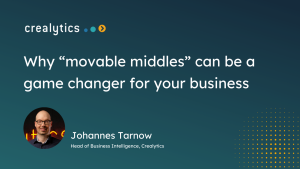The recession and changes in consumer buying behavior have led to financial struggles for many retailers. Budgets are tightening, and the boardroom and C-Suite are carefully reviewing marketing investments.
New CMOs are under pressure to deliver quick wins and establish strategic priorities as soon as possible to improve profitability.
With AI disrupting performance marketing, from media buying to creative optimization, there’s a window of opportunity for first movers. However, there is understandable skepticism around adopting AI in this changing ecosystem. As a seasoned marketing leader, you’ve witnessed countless industry trends come and go, promising the moon but delivering little.
How can you cut through the AI buzz and unlock quantifiable marketing performance?
Let’s journey back in time to understand how our current scenario unfolded.

In 2021, Nicolas Darveau-Garneau, Google’s Chief Evangelist, made a bold prediction. He anticipated that by 2024, machine learning algorithms would govern all digital campaigns. Moreover, he asserted that businesses excelling at forecasting lifetime value would gain a substantial advantage over their competitors.
Fast-forwarding to our present, some winners indeed emerged, having effectively harnessed the power of AI.
In the retail sector, for instance, companies such as the German fashion retailer About You stand out. This company is known as a driving force of innovation in performance marketing. Additionally, several traditional retailers, including Staples and Urban Outfitters, have taken a step forward by leveraging predictive CLV models to inform Google’s AI-based product, Performance Max.
If You’re Still Sitting on the Fence…
On the other hand, marketing leaders who lag in exploring the profitability opportunities available to them through AI are likely to face the following obstacles:
Lagging Professional Development and Industry Relevance: Marketing leaders lacking experience or knowledge in this domain may face a significant hurdle. This gap might slow down their career growth, lower their status in the industry, and diminish their influence and leadership within their organizations.
Declining Competitive Advantage: AI has the potential to significantly enhance marketing performance through its ability to analyze large datasets, optimize campaigns, and personalize customer experiences. CMOs who fail to adopt AI may struggle to keep up with competitors who leverage AI-driven insights and strategies and will risk outperformance and loss of market share.
Reduced Profitability and Missed Predictive Insights: CMOs who overlook AI risk relying on outdated or incomplete data, leading to less effective decision-making. This can result in ineffective marketing strategies and misaligned messaging, which can lead to poor customer experiences. Ultimately, these shortcomings can negatively impact sales and profitability. Additionally, without access to AI’s predictive modelling data, CMOs may miss key insights that could drive profitability by informing more strategic, forward-looking decision-making.
But First, the Mindset Shift: Profitability vs. Revenue
Traditionally, marketing leaders have used ROAS (return on ad spend) and other revenue-based metrics to measure the success and efficiency of campaigns.
But marketing leaders face a paradigm shift in how they approach performance advertising. Automation has leveled the playing field. Standing out from the competition no longer depends on perfecting the nuts and bolts of a campaign. It requires a strategic shift.
Recent volatility in the stock market and fluctuations in company valuation have highlighted this crucial mindset shift for the C-suite: Profitability-over-revenue.
Back to our market leaders… Why are companies like About You, Staples, and Urban Outfitters winning?
They strategically leverage AI–specifically machine learning–to scrutinize profitability over revenue.
As Nicolas Darveau-Garneau said above, they have focused on customer lifetime value as a critical business metric and it’s paying off.
The Questions You Should Be Asking:
AI has started to disrupt the building blocks of performance marketing–from bidding and media buying to creative optimization and measurement. If you’re curious about how to get started with AI in your performance marketing strategy, you may be wondering…
- How Can We Leverage First-party Data and AI to Help Us Acquire New, Loyal, and Profitable Customers?
- How Can We Use AI to Measure Performance Marketing Results More Accurately?
- How Can We Leverage Generative AI to Develop Ad Creative?
In subsequent articles, we will highlight answers to these questions to give you a full landscape of the opportunities for incorporating AI in your performance marketing strategy.
And by addressing each area, you’ll realize quick wins, set strategic priorities, and access the insights you need to get on a clear and actionable path to improve profitability.
Beyond the Buzz: The Numbers Behind the AI Hype
The boardroom is looking for visibility into profitability–not sugar-coated revenue numbers. Your relationship with the CFO and CEO has to be tight as you illustrate and build consensus around the effectiveness of your paid media investment.
And to maintain your credibility–and keep your job– you need to be 100% certain that you’ve backed up your advertising strategy with numbers. And this means using the right AI tools to audit current performance and unlock profit opportunities.
Over the last 13 years, we’ve analyzed millions of dollars in marketing spend to unlock growth opportunities for our retail clients to:
- Uncover the True ROI of Performance Marketing
- Analyze the current profitability of paid media channels, looking at factors including incrementality, eCommerce (contribution) margins, and CLV.
- Unlock Hidden Profit/ROI Lift
- Break down your growth potential with three key levers: data activation, operational improvements, and budget reallocation.
- Action New Insights with a Profitability Plan
- Get a prioritized roadmap to get the most out of your paid media investment, from short-term quick-wins to longer-term strategic improvements
- Get a prioritized roadmap to get the most out of your paid media investment, from short-term quick-wins to longer-term strategic improvements

This is article #1 in a series aimed helping marketing leaders understand and maximize the AI opportunities in Performance Marketing.
● Article #2: Leveraging AI & First-Party Data to Acquire New, Loyal, and Profitable Customers.




